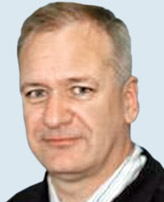Creative people, Sri Lanka's resource - Prof. Mark Taylor
By Dhaneshi Yatawara
Economic prosperity is the key figure in symbolising a country's
development. Today the key to success is innovation-based economy
coupled with scientific research and business development.
"Clearly there are several leverage points in Sri Lankan natural
resources, but the biggest resource Sri Lanka has, as in New Zealand, is
the highly educated and creative people," said Professor Mark Taylor of
Auckland University, who was on a visit to Sri Lanka recently, to
educate and enlighten the Sri Lankan research community and the business
sector.
Prof. Taylor was here on an invitation from the Government and the
program was coordinated by the Coordinating Secretariat for Science and
Technology Innovations (COSTI).
"Especially the engineering and design skills which are being
developed in your country.
In particular the coordination of the Sri Lankan skill base by COSTI
is a major structural advantage which will enable this capability to
develop and applied to the task of SME acceleration," he said.
 |
|
Prof. Taylor |
Prof. Taylor spent 20 years in technology development and line
management in heavy industry, primarily in aluminium production and
related businesses.
During this time he worked at the interface between research and
production, innovating to create higher value products, reducing energy
and materials consumption, and managing major engineering and
construction projects.
His experience in research and business collaborations has made
innovations in New Zealand benefiting the business sector and the
research community equally.
Today the team in Auckland University including Prof. Mark Taylor has
implemented a practical mechanism to bring efficiency and to obtain
better results from researches to business development both in the state
and private sectors. We had longstanding relationship with Sri Lanka, he
said. "We have Sri Lankans as senior researchers working with us.
So for the last five years we have made supply chains for various
parts of the world and some of the supply chains have been started here
in collaboration with certain sectors like rubber industry," he added.
Prof. Taylor elaborating on the Sri Lankan potential, further added
that there are New Zealand hi-tech business companies who are keen to
invest in various sectors in Sri Lankan market.
There are quite a number of opportunities for partnership - from a
research institute point of view and a company's point of view. Our
focus is particularly on small and medium scale enterprises (SME).
What we were trying to do in New Zealand is to build partnership with
institutions and SME companies with great innovative ideas and great
potentials in market.
"We see a parallel situation existing in Sri Lanka. Most of the time
we see that these SME businessmen only need support for one factor - it
may be the market or the technology," he explained.
 |
|
Research and Development
concept signpost against a blue cloudy sky |
Sri Lanka went in for open economy in 1977 aiming at bringing foreign
investments to Sri Lanka. Yet a substantial portion of the economic
development depends on Foreign Direct Investments. Thus there seems to
be a stagnation in the development of the SME field.
In this backdrop how can the SME sector be successful? "That is what
is interesting about your country. Sri Lankan experience is quite
parallel to what New Zealand experienced in the 1980s," Taylor
explained.
"This situation existed almost up to early 2000s. It was not
stagnation actually but the SME sector was moving slow.
There was less business based on innovation. Almost all the
businesses were on milk, wool, wood - more on raw materials.
Actually there were ongoing researches to improve this level. But
companies with innovative ideas did not have the technology.
The businesses were not aware of these ongoing researches and the
researchers did not cross the bridge to the business sector.
Especially the small businesses could not embark on grand
researches," explained Taylor.
There was no way to make the connection. As he further added, even in
Sri Lanka you have a wealth of small companies and a few big companies.
One piece of the puzzle missing - a proper market to promote the
products.
Around 2007, when experts of the field in New Zealand identified the
drawback in the businesses and research world, number of Universities
tried to bring in solutions and especially in Auckland University.
"Researchers banded together and proposed to the Government that we
need a different model to engage in the business sector - not only the
small ones but the large scale businesses as well. We showed a different
model which was more business focused.
It took sometime, almost two years to win the contract with the
Government. But we started to implement the new method with few
companies," he explained. From 2006-2007 to 2014 New Zealand high tech
manufacturing has grown to 4.6 billion to 7.5 billion New Zealand
dollars- almost a 40% increase. "That is the high tech manufacturing
part of the New Zealand economy.
Now it is growing faster than any other sector of the economy," he
added.
This happened through changing the attitudes of the companies. What I
have noticed with Government interventions in any country including New
Zealand is that professionals in the Government sector do not
sufficiently know about the nature of the market. It is the truth though
we all want quick results.
"I spent half my life in business. So with the experience I gathered
we the team at the Auckland University, surveyed 250 businesses for the
first couple of months and found out what they needed and their
differences in requirements.
And then we worked in the next two years with 300 companies in
detail. Whichever business came in needed help. Mainly manufacturing.
They were doing businesses in fields such as nanotechnology, food
manufacturing - all were New Zealand-based companies. During this time
we wanted these companies to join with multinational companies to find
better markets.
We built up a network with the businesses and research organisations
and it did took a considerable time for this to get established. Their
different requirements in technology had to be catered to. Companies
were clustered around these innovations," he added.
"We pulled out the technology requirements from the companies and
created PhD researches for academics and the researchers were conducted
in collaboration with the relevant companies.
It was a different way - researching what the companies wanted. For a
business there are always emergency requirements. So we researchers need
to adjust to this emergency. We called it emergency research," he said.
How did you convince the private sector to implement this initiative?
Most of the time the business sector is right about their views.
What the researchers want is the money from the company and they also
want the company to take the risk of the outcome of research. Company
pays all the money and takes all the risk.
And to me this looked like the wrong way round. With our networking
both parties were encouraged to discuss how share the risk and the cost
of the research. The discussion is about a win-win situation and not a
win-lose.
Worldwide companies have bad experiences with researches. So it took
a considerable effort to convince the business sector to initiate this
new move.
"This thought of sharing is important. This provides the companies
what they need at the correct time," Prof. Taylor added.
Today projects are getting broader and more companies are encouraged
to take more innovation attempts. And the researches do need to have a
socio economic impact.
Basic research is necessary but what is effective is a research with
a socio-economic impact. Even New Zealand does not have a big budget so
efficiency is important.
"The Sri Lankan visit was a success in terms of the research
institutions engaged and the ideas exchanged. My overall impression of
the institutions and especially SLINTECH which I visited along with
Moratuwa University, is that there is a good base of capability now for
manufacturing support for the Sri Lankan industry.
Acceleration of the SME sector was discussed in detail during the
visit, with COSTI and SLINTECH, and a roadmap for bringing this to
fruition is not out of reach, Prof. Taylor said with confidence.
"I think it is fair to say that there will need to be much more
financial resource applied to this sector through COSTI in terms of
guidance and selection of the lead companies in the next year for
significant process to be made," he said. |

